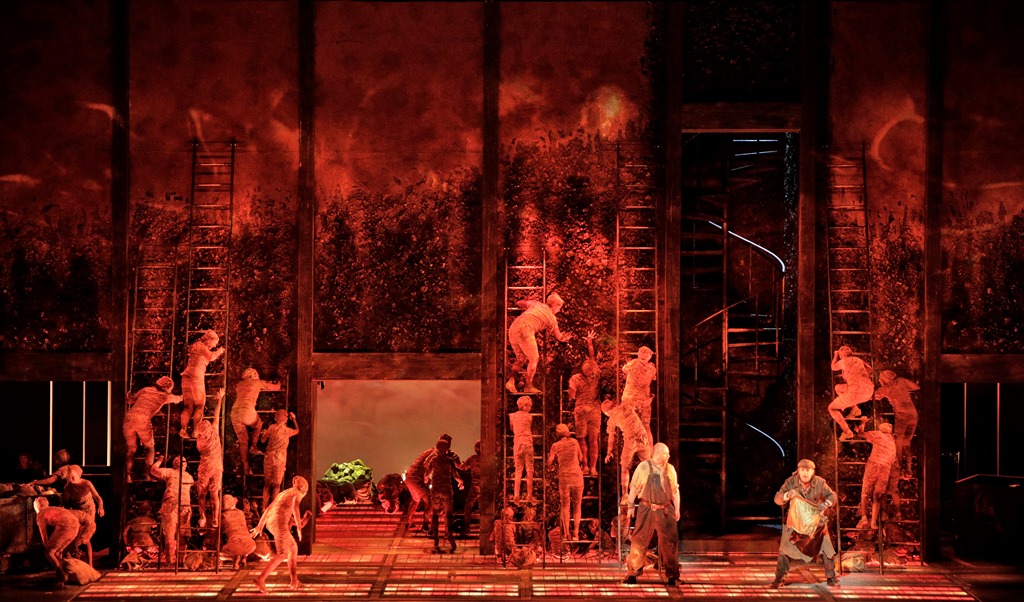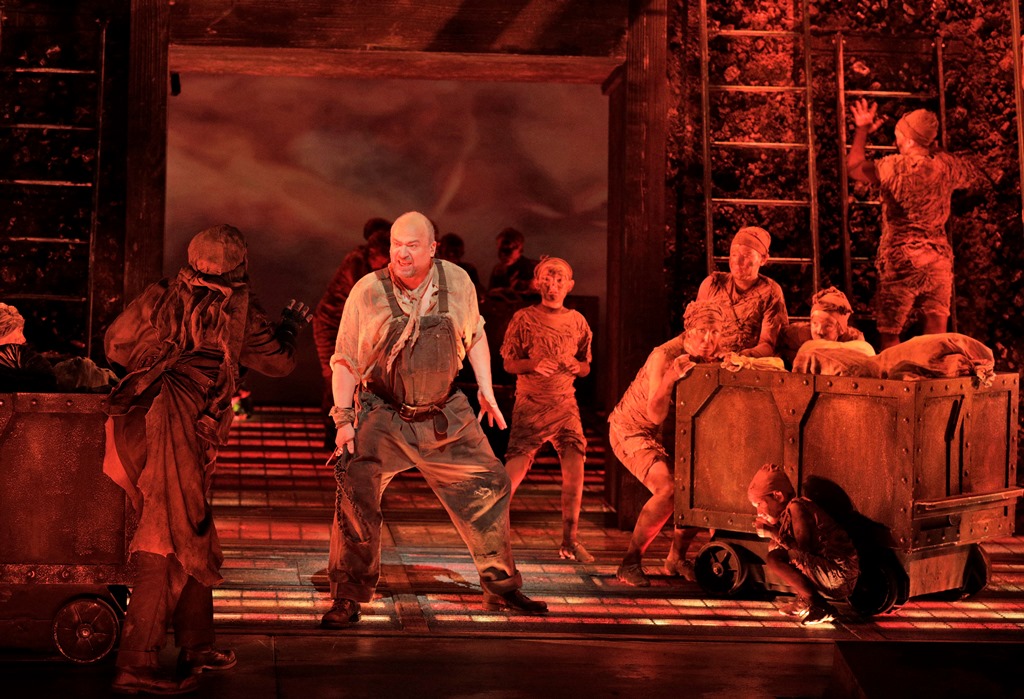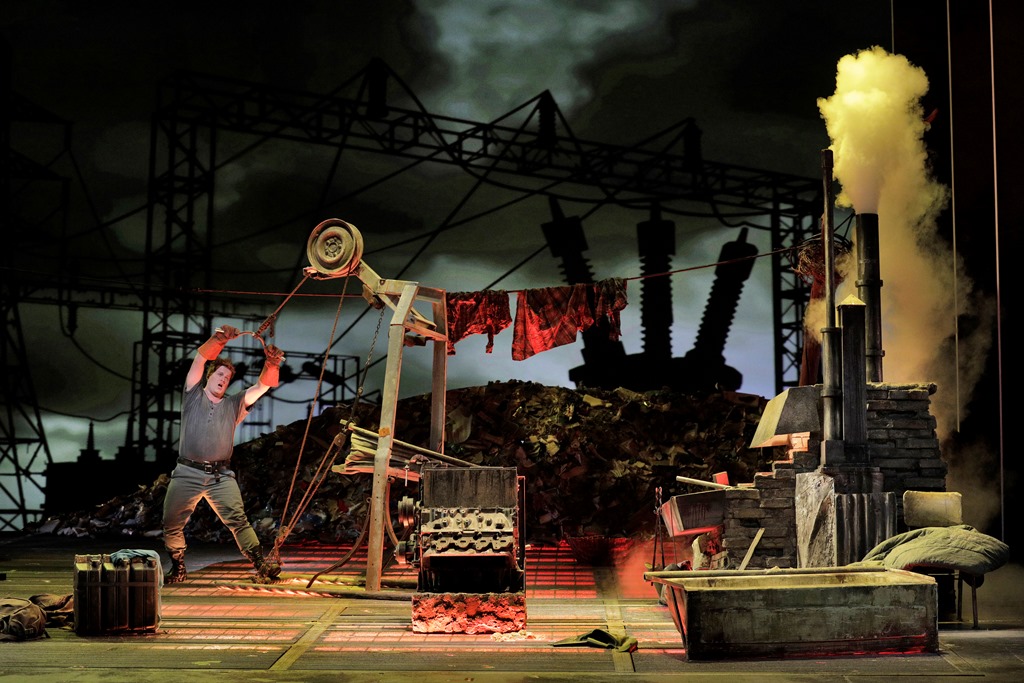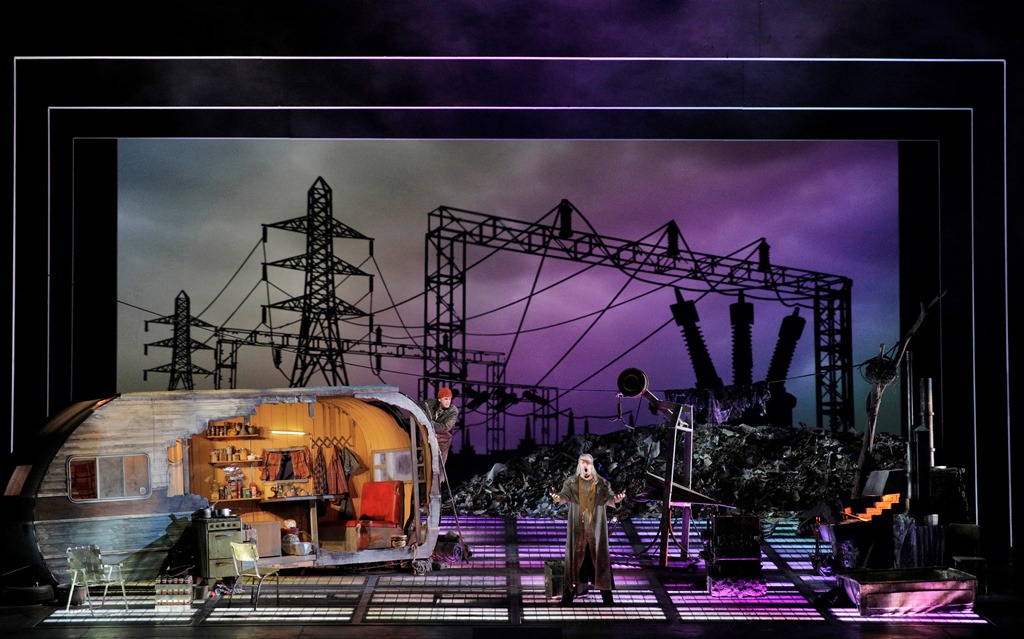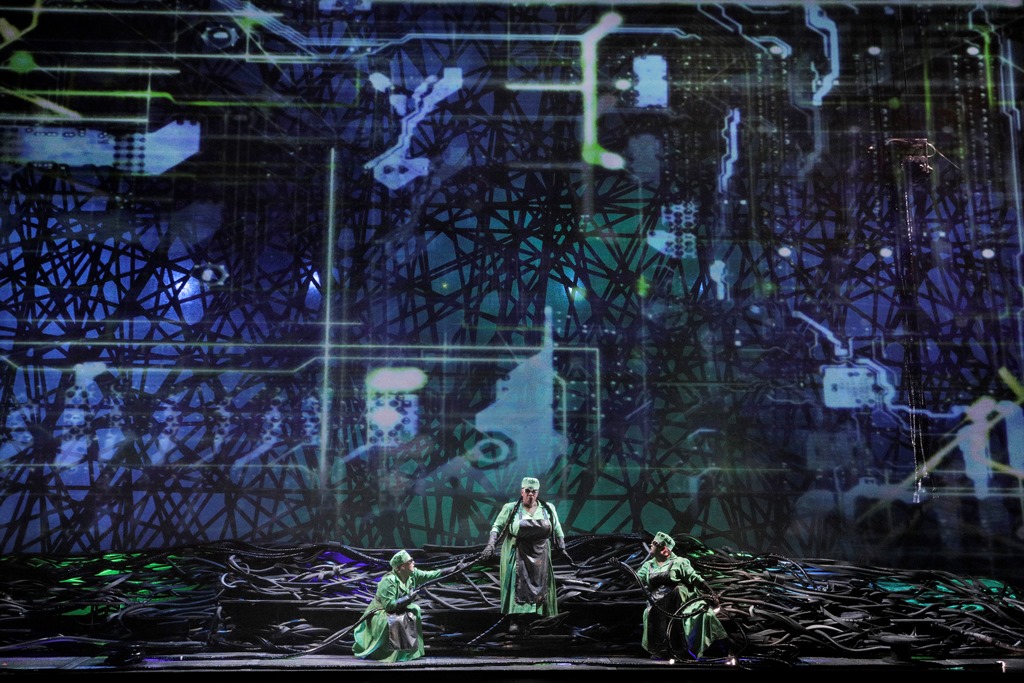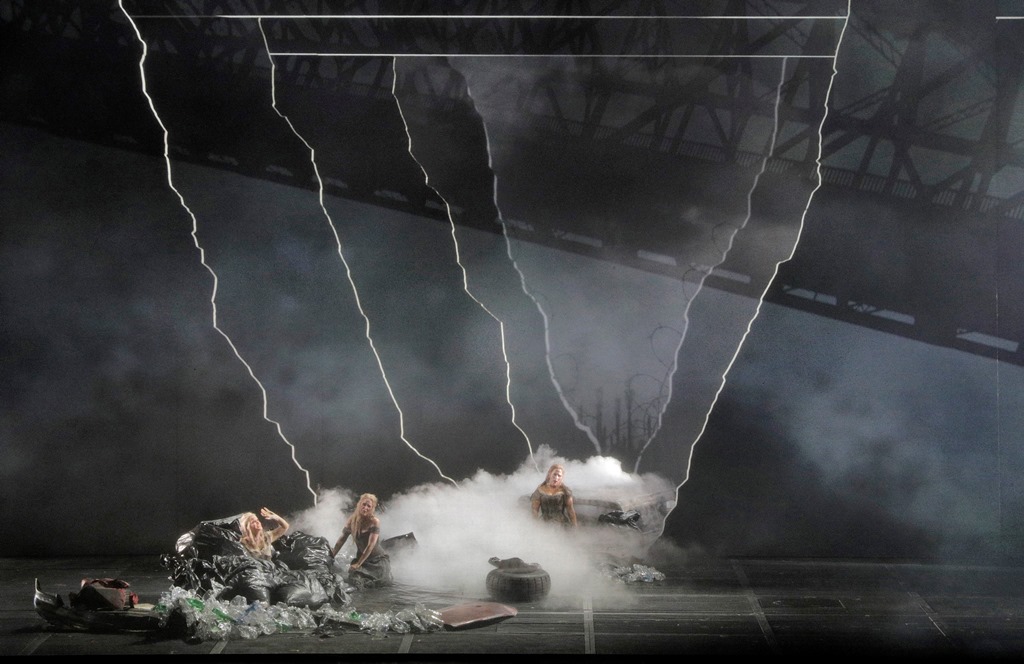San Francisco's 'Ring' Is a Vocal and Hi-Tech Tour de Force
/By Elsa Tranter
6/27/2018
Photo credit: Cory Weaver / San Francisco Opera
DAS RHEINGOLD
Tuesday, June 19
Long-awaited by ‘Ringheads’ around the world, San Francisco’s production of Richard Wagner’s “Ring of the Nibelungs” is in full-swing at the Opera House these days. It’s been a long seven years of famine for those of us who crave this total immersion into the most gripping and passionate of all performance pieces. Along with the four operas, or music dramas (as Wagner preferred to call them) performed three times each over a three-week period, there are lectures, films, symposia and photo exhibits. A few people have even been spotted with helmets and spears heading for the theater. It is a true Festival, with lots of bang for the buck for those who make it to San Francisco. The level of excitement is quite high and so far the performances have been meeting expectations.
The history of the writing of the Ring is interesting to note. Wagner first started writing the story of Siegfried and his death. He then realized that he had to write the back story to that—so he wrote “Die Walküre” which, among other things, tells the story of Siegfried’s conception and birth. But that wasn’t enough information, so he wrote the prologue to all of that, “Das Rheingold”. Partway through writing “Siegfried”, he took a break for many years, wrote several other operas, and finally went back to complete the project, with the last part of “Siegfried” and the final opera of the Ring Cycle, “Götterdämmerung”. Taken as a whole, it is about seventeen hours of music and singing, usually performed over a week’s time, with a cast of hundreds, if not thousands, and some enormously taxing vocal roles (not to mention the orchestra, which gets no respite for up to five hours of playing in an evening).
The story of the whole is one of monumental quest for power and the renunciation of love in order to get it. In this production, initially produced in 2011 by the American Francesca Zambello as ‘an American Ring’, there is also the destruction of nature, corruption, lust, betrayal, hatred, jealousy and fear, and the suffering of the downtrodden. It includes gods, humans, sub-humans, giants, dwarfs and maybe unnamed species. Wagner, unusual among composers, wrote all his own librettos, as well as breathtaking music. He was a complicated man, both loved and reviled in his own time and even now; but there is little to argue the brilliance of his musical talent.
This production, like the original 2011 version, is conducted by Donald Runnicles, who was Music Director of the San Francisco Opera for many years and returns for the first time in several years. It has many similarities in cast, sets, and costumes, with some advanced updates in technology.
On to the beginning: “Das Rheingold”. Unusual to opera (but not for Wagner), the opera begins with a darkened stage, the conductor already in place in the orchestra pit. We don’t applaud his entrance, but wait in rapt anticipation, holding our collective breaths, for the opening bars. The music of water in gentle waves is what begins the evening, very softly, as the curtain rises on the Rhinemaidens frolicking in the water. What follows is the attempt of Alberich, the Niebelung of the underworld, to steal the gold from the river, his renouncing of love in his efforts to get it, and then having it re-stolen up the line each time with negative effects for those who get it. This scene is very traditional, with timeless staging and costumes.
We move into 20th century corporate America where we meet the god Wotan and his family. He has hired giants to build Valhalla, his palace in the upper world, and now has to steal the gold to pay them off. You can tell it’s not going to end well.
There are many twists and turns and complications, while all the time the singers are making the most beautiful music to the accompaniment of superb orchestration. And at the end of the 2 1/2 hours, one act, marathon, Valhalla is paid for and the gods ascend, leaving behind a few bodies. It felt somehow too current.
The singers were uniformly excellent, led by Greer Grimsley as Wotan, Falk Struckmann as Alberich, Stefan Margita as Loge, Jamie Barton as Fricka, with equally effective, if smaller, roles sung by the Rhinemaidens Stacey Tappan, Lauren McNeese and Renee Tatum; Brian Mulligan (Donner), Brandon Jovanovich (Froh), Julie Adams (Freia), Andrea Silvestrelli (the giant Fasolt), Raymond Aceto (his brother Fafner), David Cangelosi (Mime) and Ronnita Miller (Erda). Finally, there were uncountable Nibelungs in a couple of scenes, scrabbling around in excellent choreography. Particularly notable were Alberich and Loge for their ability to get into character and the two giants towering over everyone on stage—their scene with the kidnapped Freia brought back memories of Fay Wray in King Kong. Jamie Barton’s Fricka seemed a little tentative vocally—but in general the performance was well-rounded and powerful.
The orchestra played brilliantly; Runnicles seems to bring out the best in them (of course they were all helped along by the beautiful music). The musicians and the audience appeared to be happy about his return to the pit at SFO. And he seemed pleased at his reception. It was an evening to savor, with the exciting reminder that there are three more operas ahead before we have to face reality again.
DIE WALKÜRE
Wednesday, June 20
Much has happened to Wotan and company since the prelude to the Ring, “Das Rheingold”, (so this is Part I); though only a day has passed in the lives of us mortals. Wotan has fathered Brünnhilde, his favorite warrior maiden (the Valkyrie of the title), and her eight Valkyrie sisters with the earth goddess Erda (notably not with his wife Fricka); in addition, on a visit to earth, he also fathers the twins Siegmund and Sieglinde with a mortal woman. And the sole remaining giant, Fafner, who killed off his brother as soon as they together got the gold, has turned himself into a dragon to protect his horde.
This opera is in many ways the most traditional and certainly the most human, of the four parts of the Ring—love, marriage, incest, domestic violence, adultery—very modern! It also has some of the most beautiful and moving music to be heard anywhere. For those reasons it is the most performed, on its own, of all the four.
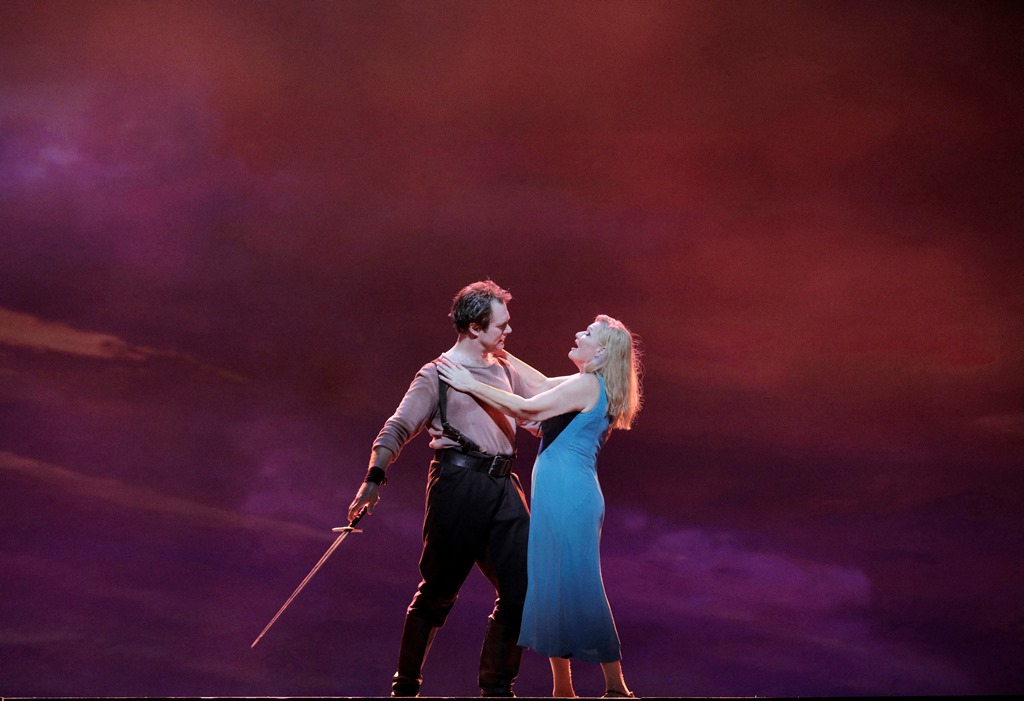
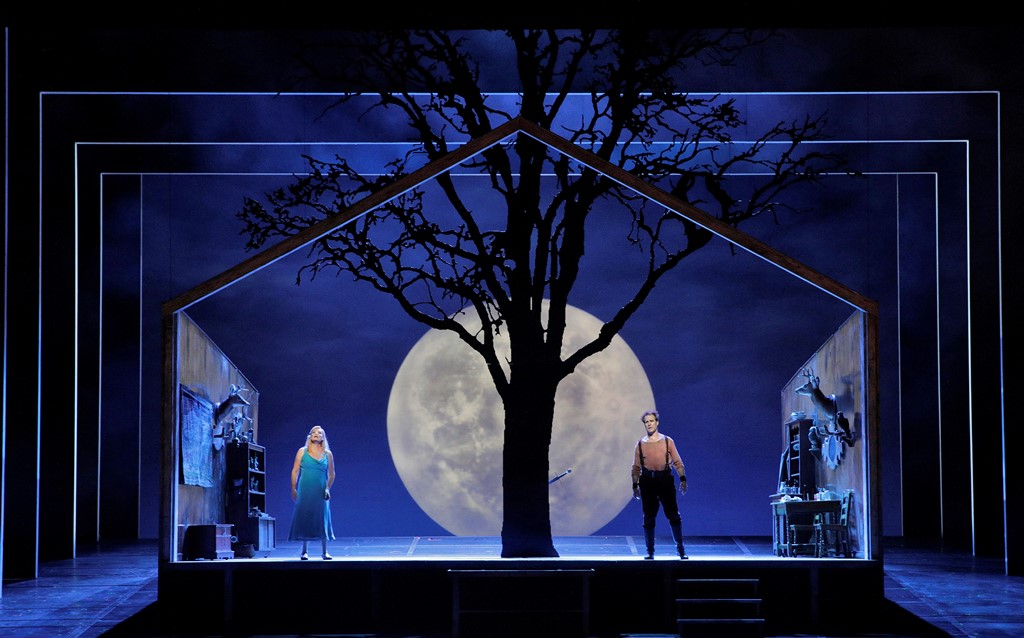
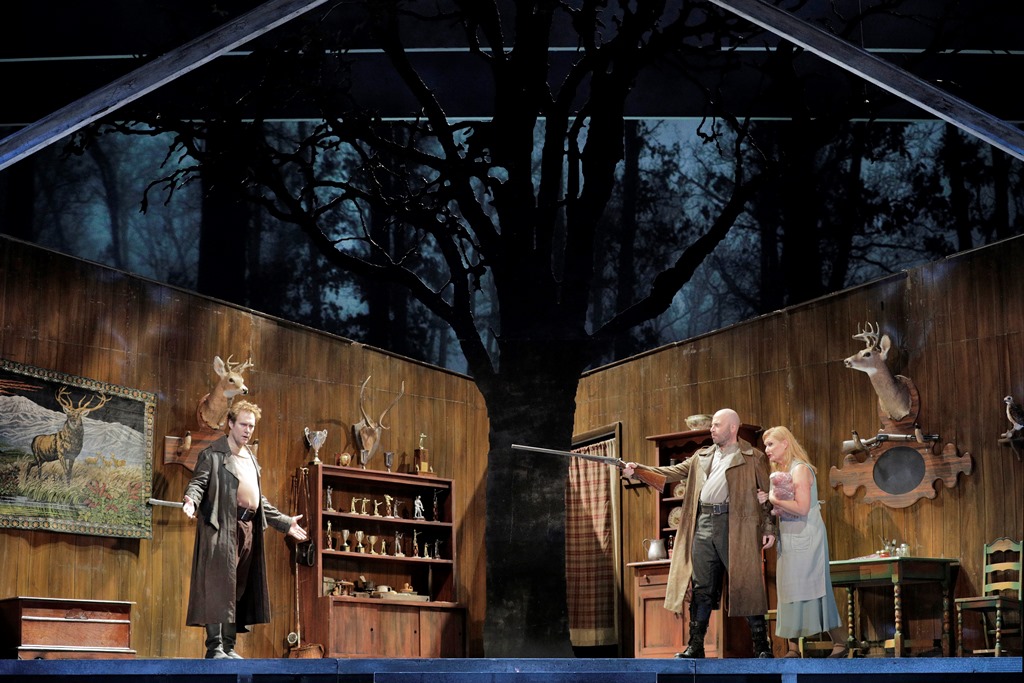
San Francisco’s production, directed by Francesca Zambello, and conducted by Donald Runnicles, is quite similar to the production which had its debut in 2011. It felt familiar and totally satisfying. There have been some changes, mostly in the technological area, with lighting and background visuals. All of these draw in the viewer and keep one’s attention through the very long scenes with little action. Mark McCullough’s lighting, Michael Yeargan’s sets and Jan Hartley’s video projections (remounted by S. Katy Tucker) were varied and eye-catching but never distracting from the characters or their singing. The costumes by Catherine Zuber with a few exceptions were well-blended into the scenery. The more modern touches (IKEA sofas, too-sophisticated evening dresses, Wotan in a three-piece suit) were more distracting than effective.
The cast includes Karita Mattila as Sieglinde and Brandon Jovanovich as her long-lost (and initially unrecognized) twin Siegmund; Raymond Aceto as her husband Hunding, Greer Grimsley as the god Wotan, Jamie Barton as his wife Fricka, Iréne Theorin as Brünnhilde, THE Valkyrie, and Julie Adams, Melissa Citro, Renee Tatum, Nicole Birkland, Sarah Cambridge, Laura Krumm, Renee Rapier, and Lauren McNeese as her sister Valkyries.
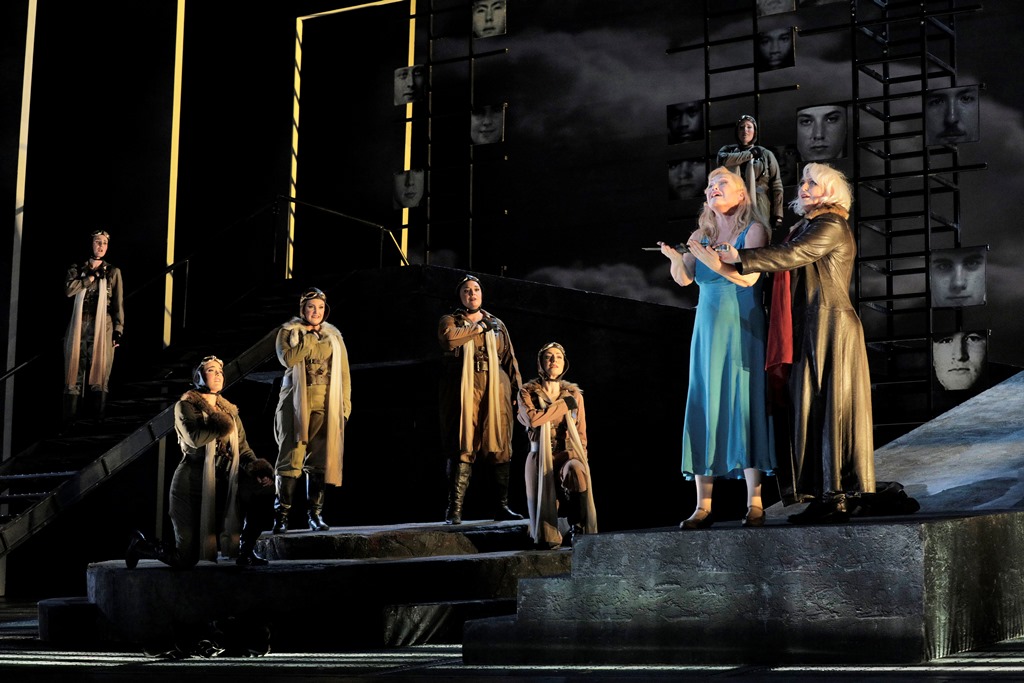
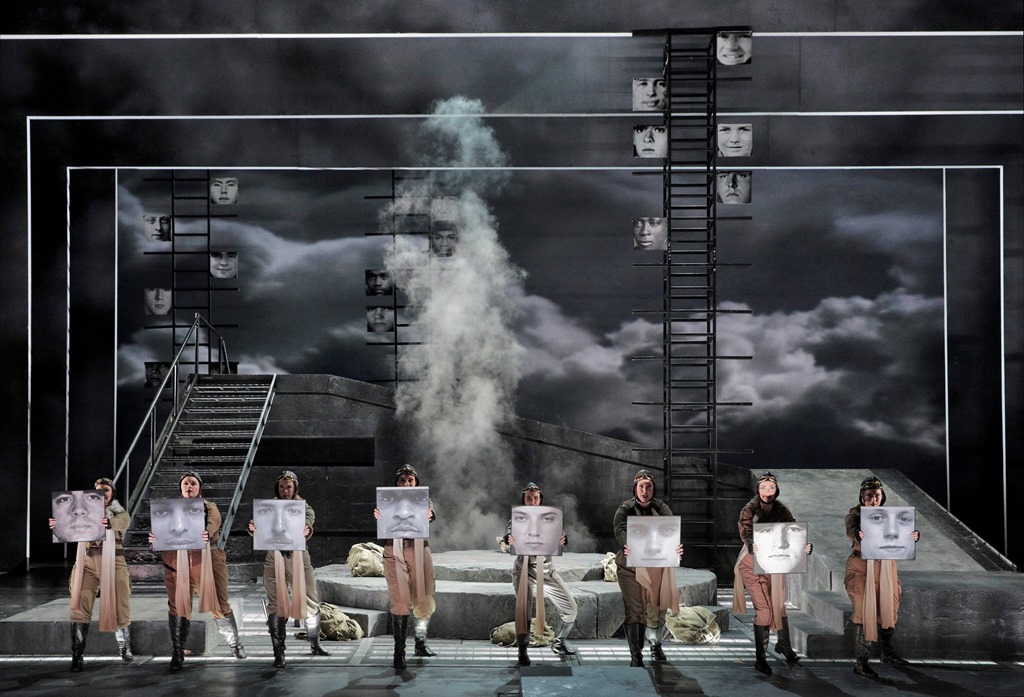
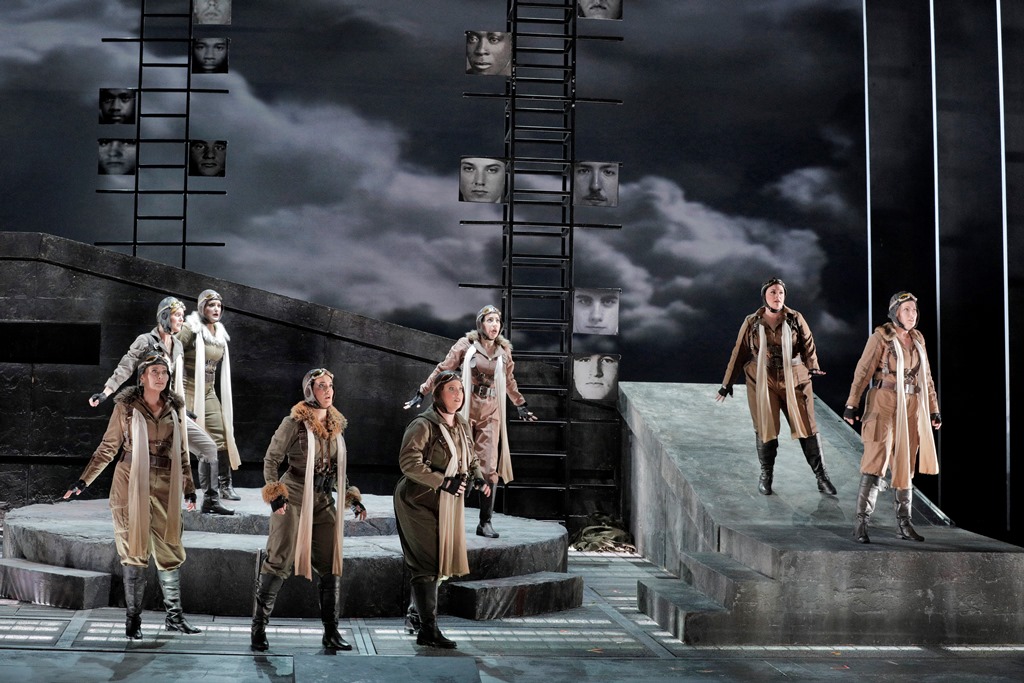
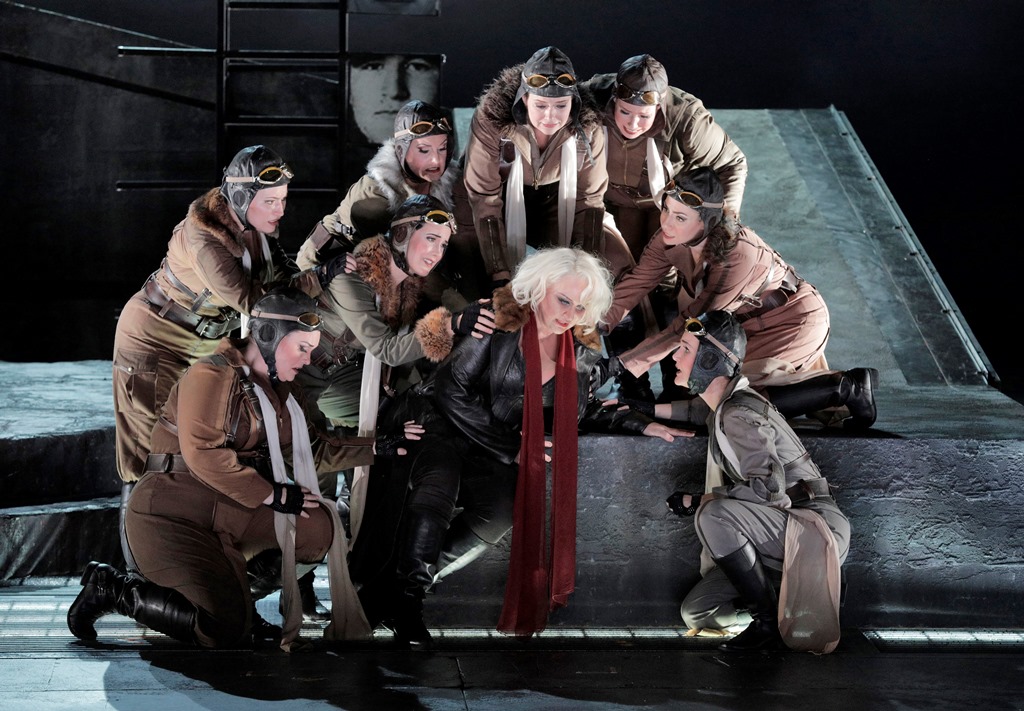
Iréne Theorin was a late addition to the cast, only coming on board a few weeks ago as substitute for the ailing Evelyn Herlitzius. The Swedish soprano has sung Brünnhilde in many of the world’s great opera houses and we were lucky that she was free to join the cast. Her Brünnhilde was vibrant and vocally commanding (although I thought her white hair made her appear older than she should have been. There has to be something that isn’t perfect!!)
Sieglinde and Seigmund were well-matched physically and vocally and made a credible pair of lovers, although Sieglinde seemed to struggle vocally a bit in certain places. The macho domesticity of Hunding with his wife was a little over the top—but maybe it was intended as a modern reminder of all the current publicity about domestic violence.
Wotan and Fricka’s argument about the relative importance of love and passion versus legal commitment was powerfully delivered and seemed as relevant now as ever. Jamie Barton redeemed herself from her (to this reviewer) less strong portrayal in Rheingold and gave an outstanding performance. Updating that scene to the 1920s with Wotan as a capitalist in his top of the skyscraper boardroom didn’t work for me; it was one of the very few modernisms that didn’t fit in with the whole. The singing was no less strong, so it’s a small quibble.
The Valkyries entrance as paratroopers hasn’t changed in seven years and was still dramatic and effective. The photos that they hold of the dead warriors (whom they are taking to Valhalla) are portraits of American soldiers killed in one of the U.S.’s many wars, past and present; that was a good example of bringing the opera up to the minute that wasn’t jarring.
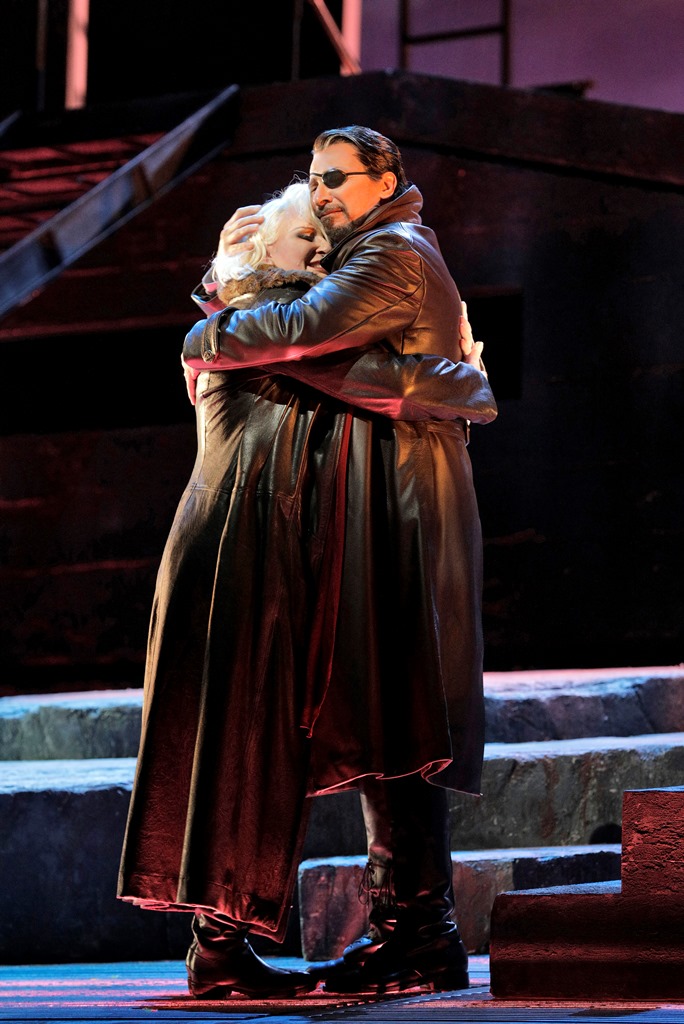
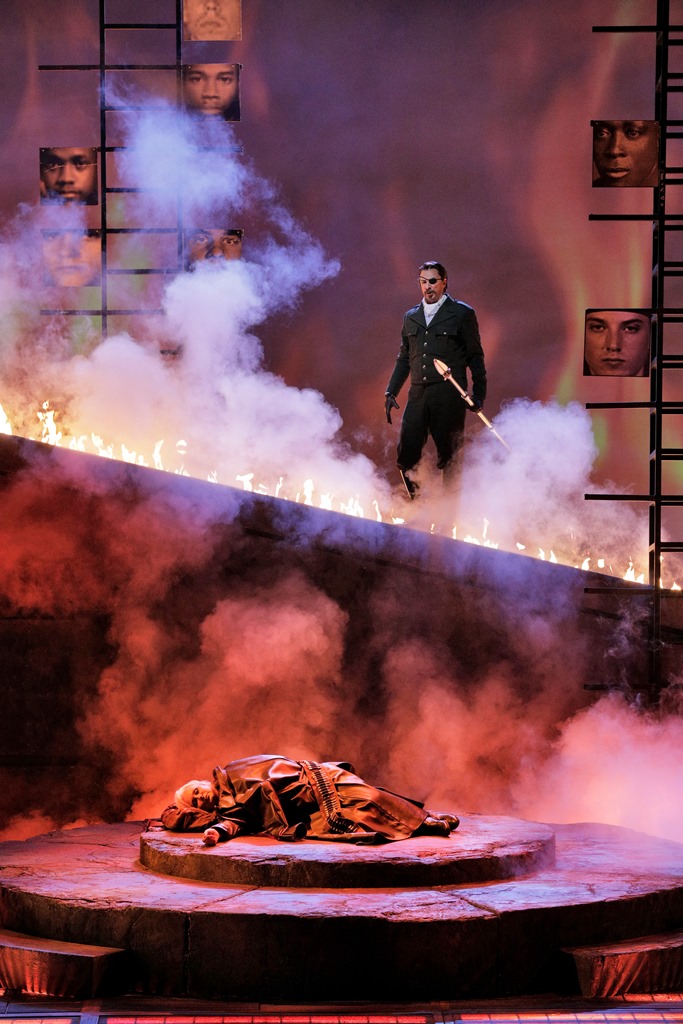
And of course the dramatic ‘Wotan’s Farewell’ is one the best scenes in opera. The father takes away his daughter’s ‘godliness’ and leaves her at the mercy of mortal man, but at least surrounds her by a wall of fire so that only a ‘man who knows no fear’ will break through to claim her. The music is soaring and Wotan and Brünnhilde were both up to the task of convincing us of their love and devotion. It’s always a thrill to watch the curtain come down on the stage all aglow (though it is more than a bit annoying when people start applauding before the music comes to an end). (Keep your eyes on the conductor, people, and don’t clap until he lowers his hands.) Altogether a breathtaking evening of music and one that left the patrons very energized and fulfilled. A day of rest before moving on to “Siegfried”…
SIEGFRIED
Friday, June 22
Anticipation was high for the third installment of the Ring on a very warm San Francisco evening. The opening chords sounded with visions of burned-out wasteland and other environmental devastation before the curtain opened on a garbage dump surrounded by power transformers, where Siegfried and Mime (his malevolent guardian) are living in a wonderfully detailed trailer (constructed of real trailer parts/furnishings). Off and running with a youthful and brash American heldentenor Daniel Brenna, making his San Francisco Opera debut in the title role. He was very credible as the teenaged Siegfried, though in fact he is not all that young; he is a great addition to the international stage. He had excellent swagger and bravado (after all he knows no fear) and even the small motion of raking his hands through his punk hair spoke of his youth.
The re-telling of past events takes up a lot of time in this opera and can often seem to drag along (Ring fatigue it could be called), but in this performance the combination of engaging and lively singers, brilliant orchestral playing and significant stage interest kept one’s attention throughout the evening.
There were many extended one-to-one interactions, each one captivating: Siegfried with Mime (played with great physical dexterity by tenor David Cangelosi); Alberich (played with great power, although needing a little help from the prompter, by Falk Struckmann with Wotan, Greer Grimsley (now in disguise as the Wanderer and showing his age and world-weariness but also looking much more god-like than in “Walküre” with Fafner (a hulking Raymond Aceto, in disguise as a dragon which looked like a giant mechanical tank-like creature); Mime and Wotan; Wotan with the earth goddess Erda (a lush-sounding mezzo-soprano Ronnita Miller) re-uniting and telling of what could be construed as a rape that led to the birth of Brünnhilde; Siegfried with the forest maiden (played as a British ‘bird’ of the mid-1960’s by soprano Stacey Tappan, who gave a 'trillingly' vibrant display of birdsong; Siegfried with Fafner, during which Siegfried slays the dragon; Siegfried with Wotan, where the son shatters the spear of the father (who is still in disguise and not known to his son); and finally, Siegfried with Brünnhilde and the rapturous awakening to life and to love of the sleeping woman, no longer a goddess. Alas, there is no way around the titters from the audience when Siegfried takes off Brünnhilde’s armor and declares “this is no man”. It was interesting to note that in the nineteen-plus years that she has been sleeping surrounded by fire, Brünnhilde’s hair has grown to be quite long—otherwise she looks the same (still don’t like the color).
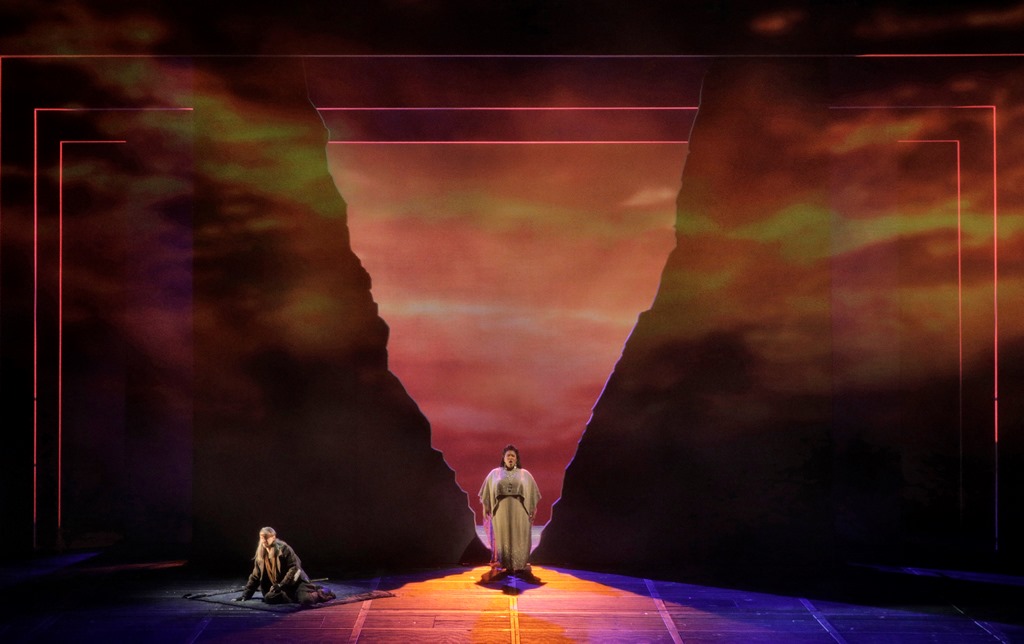
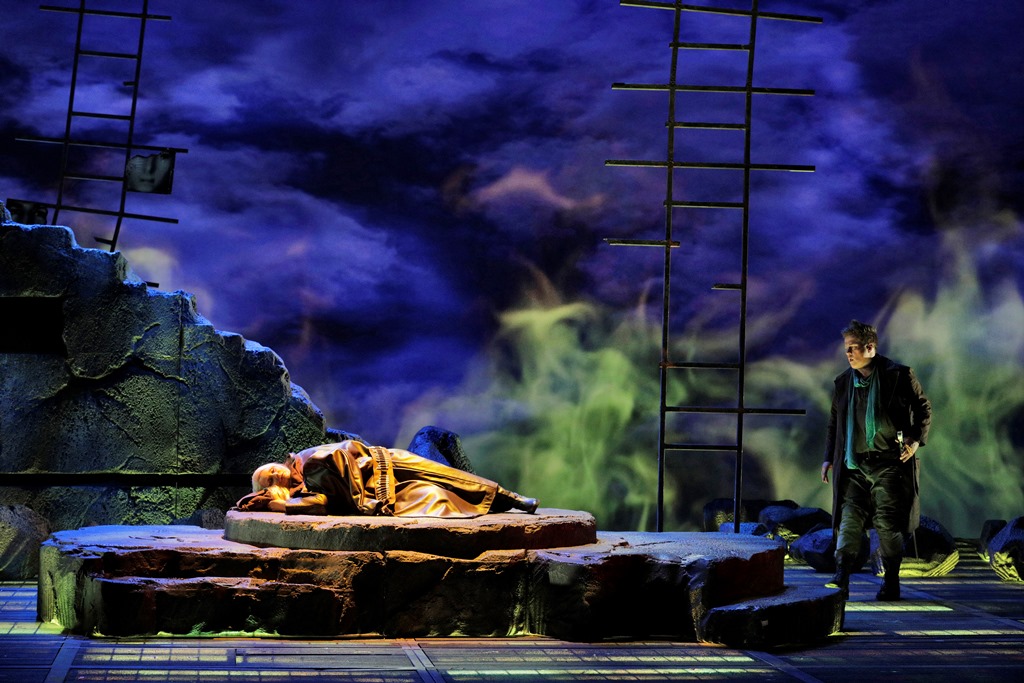
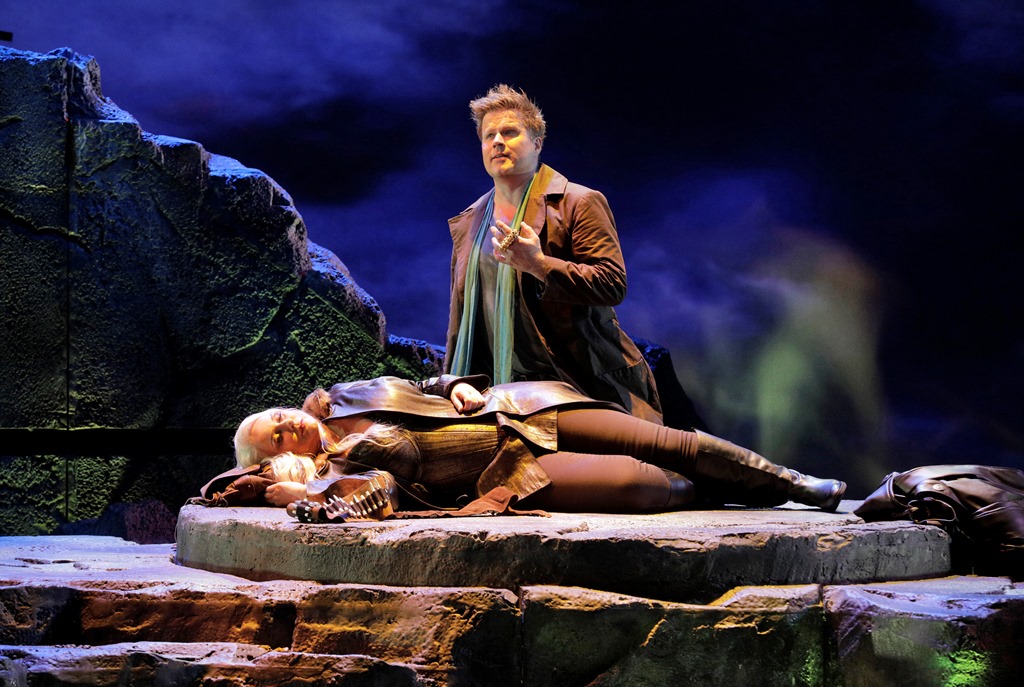
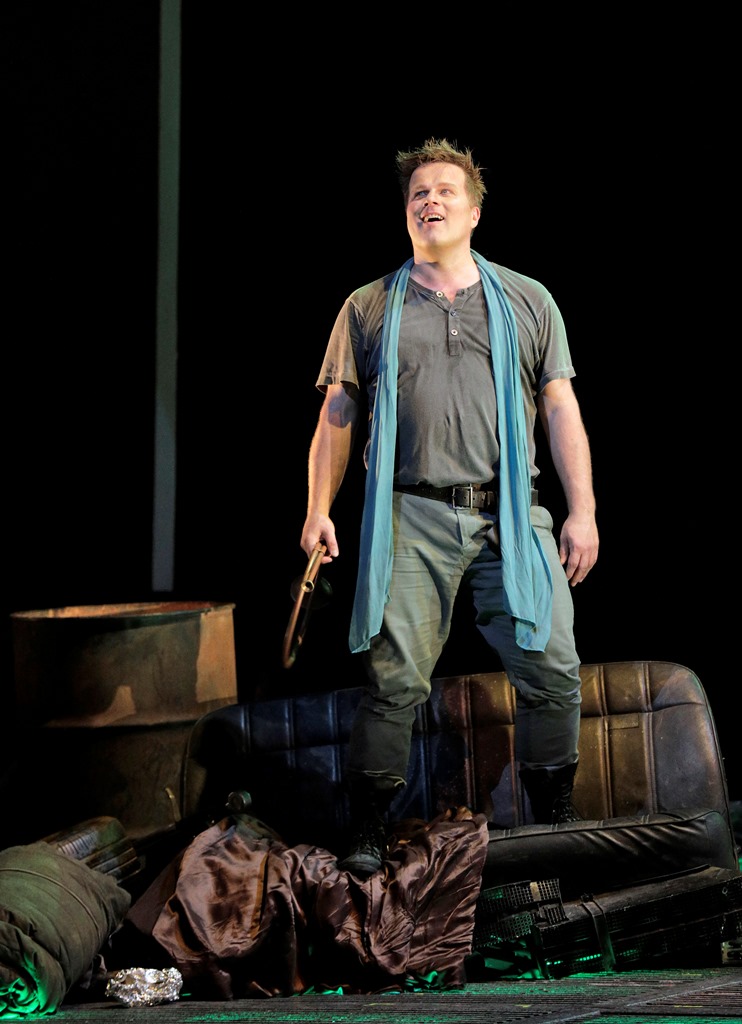
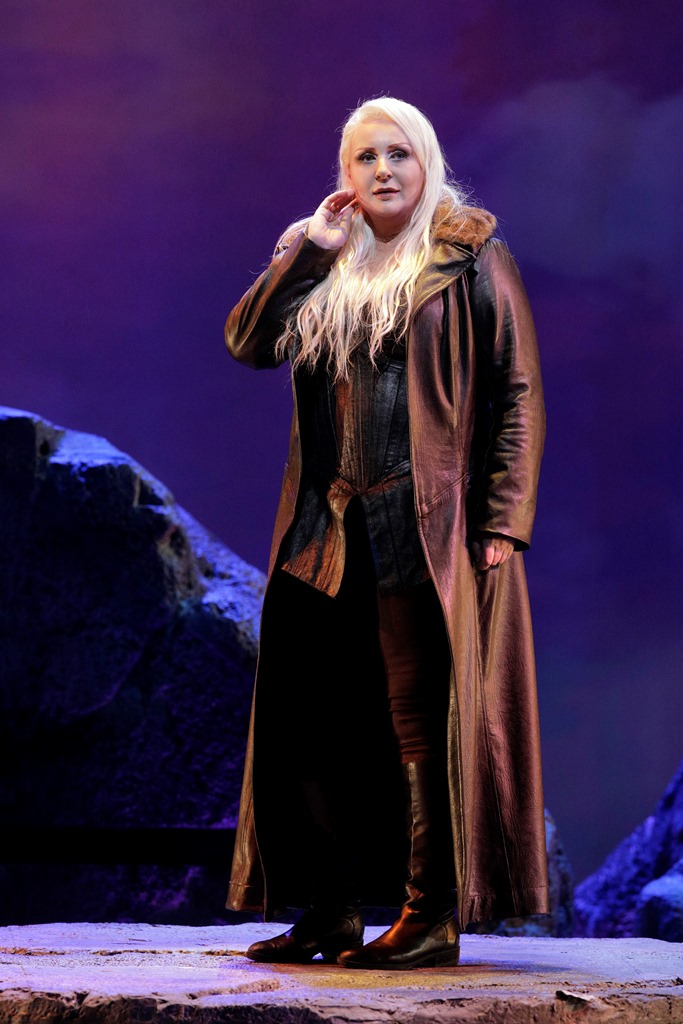
Each of the characters has a chance to express their feelings and interact with the other in a long and meaningful way. And each of them was so believable—the music could have gone on forever. Considering the broad scope of the story and the size of the gigantic stage, there was a great deal of intimacy in this opera.
The costumes by Catherine Zuber worked well without calling special attention to them. One very nice touch was the blue scarf that Siegfried wore throughout this opera (and the next). It was taken from the dress of his mother, Sieglinde, who died giving birth to him). In the overall color-neutral costumes, it made a vivid impression. The orchestra played sparklingly all evening; Donald Runnicles and his players got much deserved applause before the acts and at the end. The almost five hour long evening seemed to fly by.
GÖTTERDÄMMERUNG
Sunday, June 24
The last part of Richard Wagner’s “Ring of the Nibelungs” got off to a multi-cultural start on Sunday as opera-goers mixed with Pride Paraders and partiers in the area around City Hall and the Opera House (the performance started at 1:00pm, just as the parade reached its finishing line just a block away). Many opera goers got in the Pride spirit and came in rainbow colors to the opera for the grand finale. There were more empty seats than previously, probably traded in for a less frenetic Sunday afternoon.
We know from the title that this is going to be a day of darkness that will not end happily. In the opening prologue the three Norns (sung capably by Ronnita Miller, Jamie Barton and Sarah Cambidge) are busy weaving the rope of fate. Siegfried (Daniel Brenna) and Brünnhilde (Iréne Theorin) awaken from their night together and he talks about going off in search of adventure; he gives her his Ring (taken earlier from the slayed dragon) as a pledge of his love but accepts his need to leave.
In Act I we meet the Gibichungs, a human family, led by Gunther (Brian Mulligan) and his sister Gutrune (Melissa Citro), along with their half-brother Hagen (Andrea Silvestrelli) who is the son of Alberich the Nibelung. Who should turn up at their door but our hero Siegfried, still unbearably naïve. In a complicated plot, they cause Siegfried to lose his memory of Brünnhilde and agree to marry Gutrune while Siegfried goes to get Brünnhilde and marry her off to Gunther. Waltraute (played to great effect by Jamie Barton) warns her sister Brünnhilde still on her rock that all is doomed if she doesn’t give the Ring back to the Rhinemaidens. Of course she doesn’t agree. Eventually there is a double wedding and poor distraught Brünnhilde doesn’t know what is happening, except that she has been betrayed and the ring is torn from her finger. Ultimately she joins the plot to kill the unfaithful Siegfried.
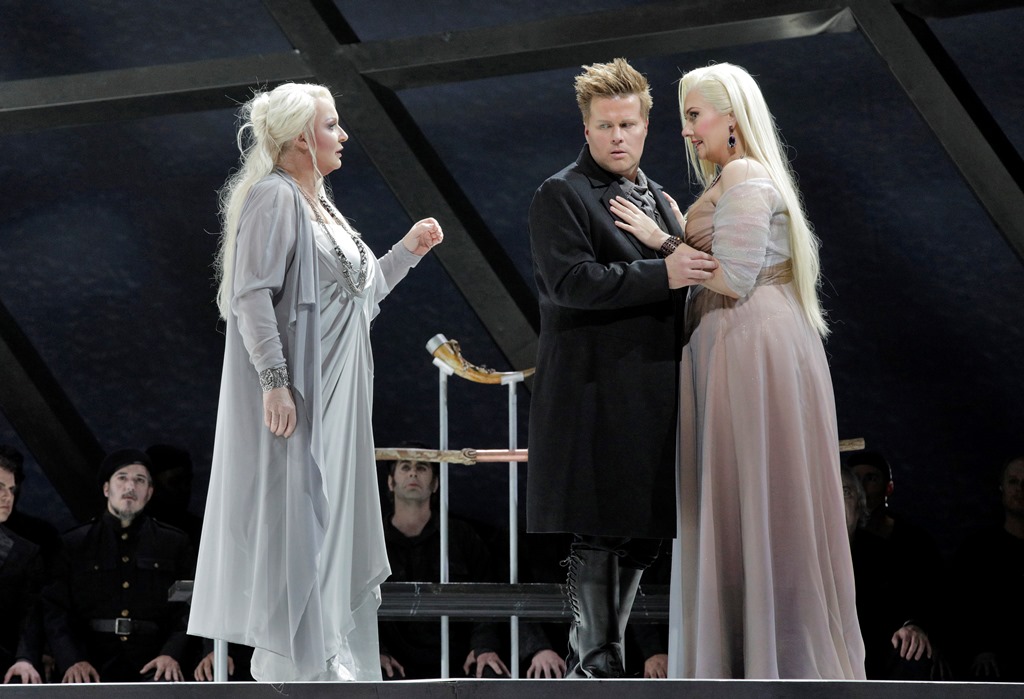
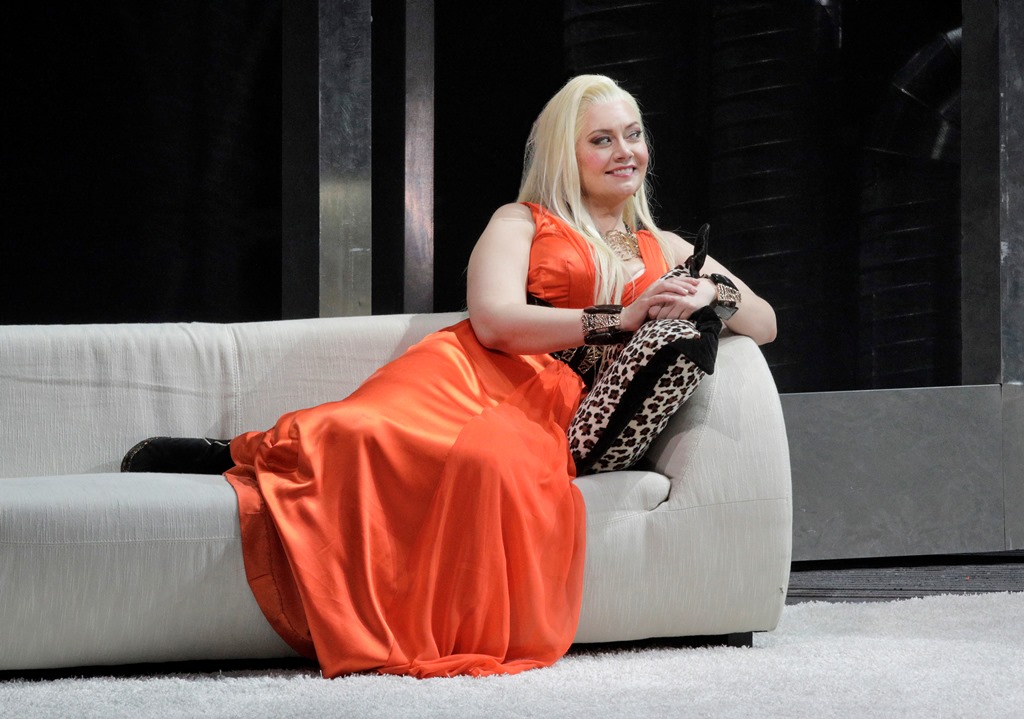
On the banks of the destroyed Rhine, creatively staged, the three Rhinemaidens (Stacey Tappan, Lauren McNeese and Renee Tatum) looking more bedraggled than in Rheingold but still in amazingly good voice, are sorting very real garbage (collected by the opera company staff!); the colors are very muted shades of green and brown. Siegfried, Hagen and Gunther all show up wearing bright orange protective gear. Siegfried is killed, Brünnhilde orders a funeral pyre built for him and, musing on the gods’ responsibility for his death, returns the ring to the Rhinemaidens and walks into the flames to join him in death.
As the world burns and the gold is returned to the river, the music soars, the curse is broken and there is a sense of redemption and re-birth (symbolized a bit too cutely by a young girl planting a tiny tree at the front of the stage.
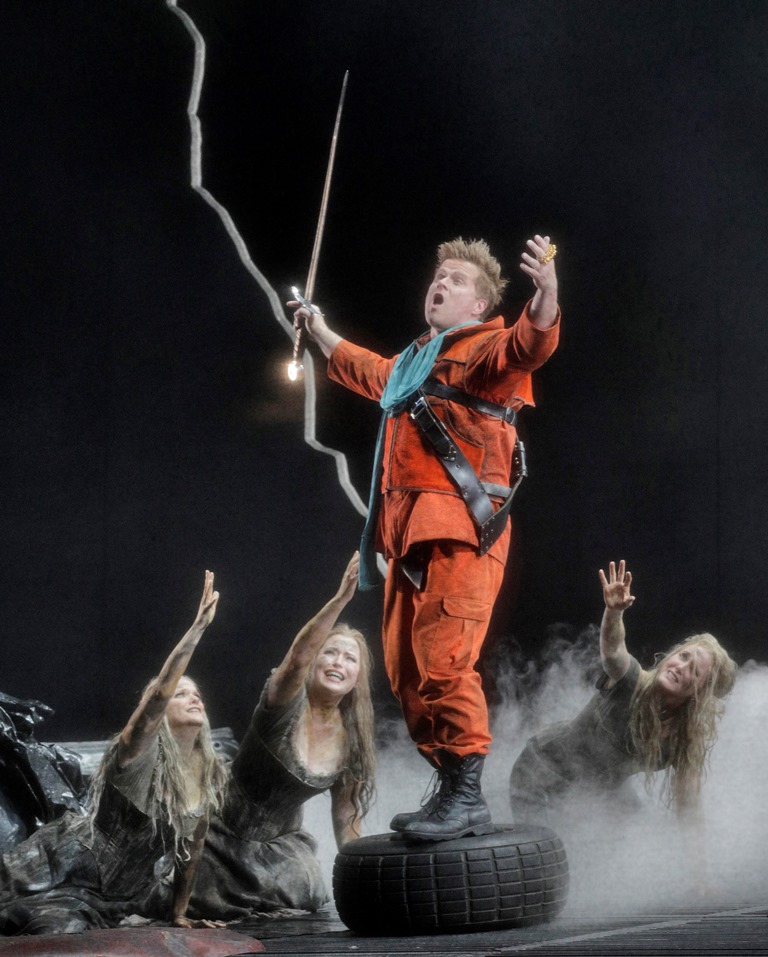
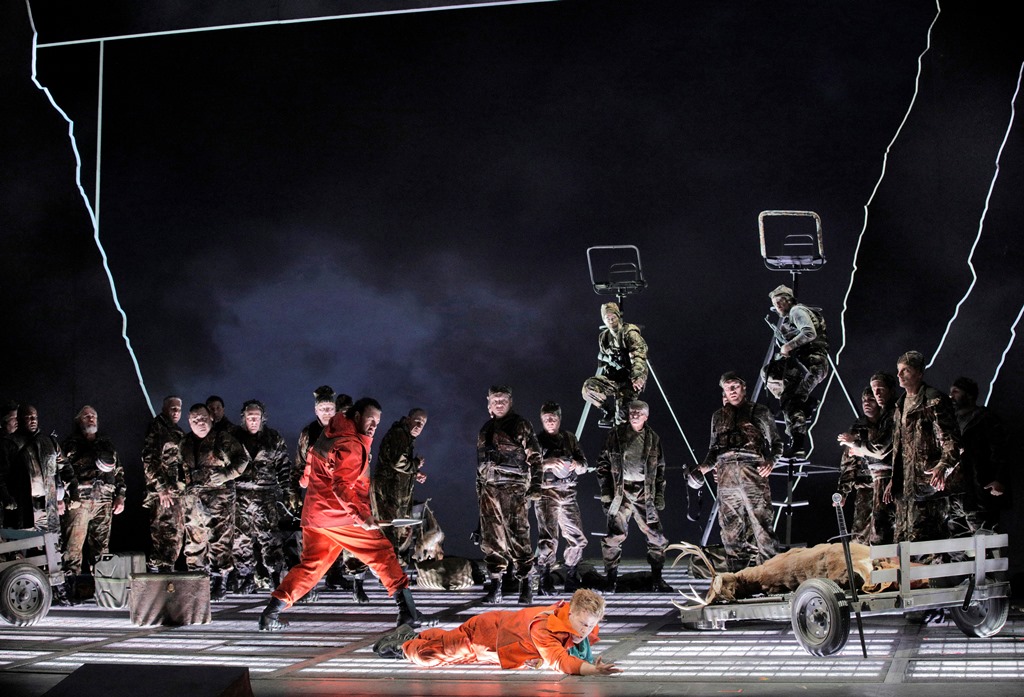
The staging and directing (Francesca Zambello), lighting (Marc McCullough), sets (Michael Yeargan), costumes (Catherine Zuber) and projections (Jan Hartley and S. Katy Tucker) were well thought through and, for the most part, extremely effective; they added to the whole without distracting from the singing.
Following the usual curtain calls and wild applause for the cast, including the chorus and chorus director Ian Robertson (who had some very minor but, as always, extremely effective scenes in the last act), the full orchestra, the production team as well as stage hands, all appeared on stage and conductor Donald Runnicles brought out co-principal horn Kevin Rivard, who had played the very taxing horn calls of Siegfried, to take a bow with the principals. Everyone was beaming, both on stage and off.
Apparently there is a tradition in Seattle of Ring goers dressing up in different colors for each of the four performances: Green for Rheingold; Red for Walküre; Blue for Siegfried and Purple for Götterdämmerung. A few people did that in San Francisco, but it would be great if lots and lots of folks did. Too late for this year, but maybe next time!!
It was a marathon week of music of the very highest standard and overall excellence with an outstanding cast of singers and superb orchestral playing. It was a bit of a downer to think that it was finally over—Das Ende and to have to re-enter the real world with the detritus from the Pride Festival —no sense of re-birth there. Still, the third and final Ring Cycle starts on the 26th for those true fanatics (count this reviewer as one of them).
Bravi Tutti!

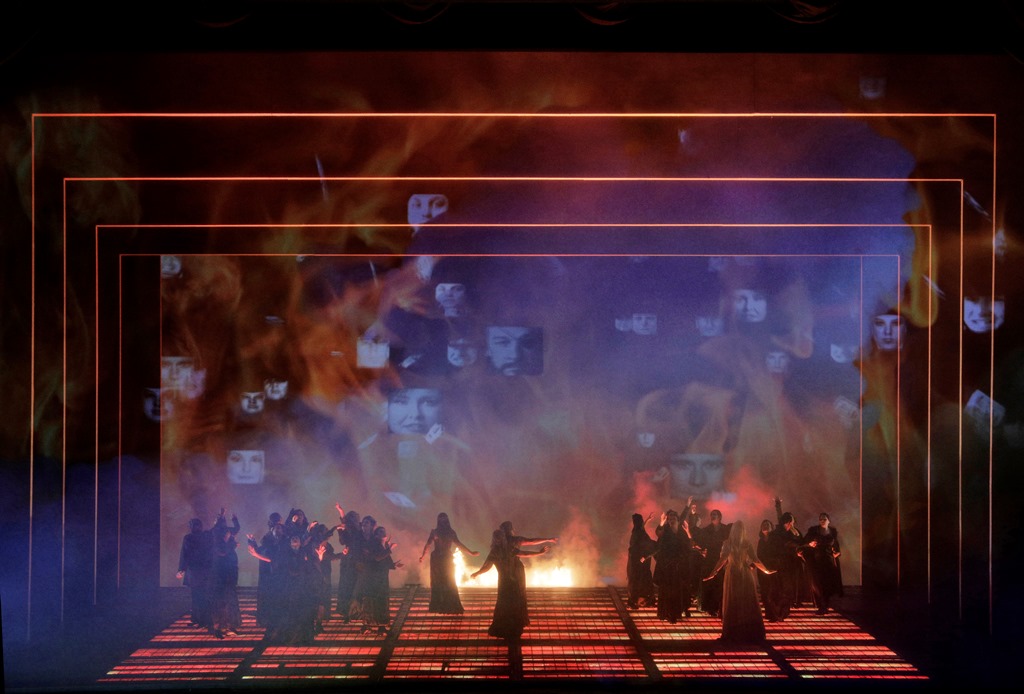
Elsa Tranter is a Bostonian who has lived in Berkeley for over 40 years and has been an opera goer for most of those years. She worked as a graduate student adviser at UC Berkeley and still attends Cal Performances regularly. Her favorite composer is Wagner and her favorite opera is Tristan und Isolde.





